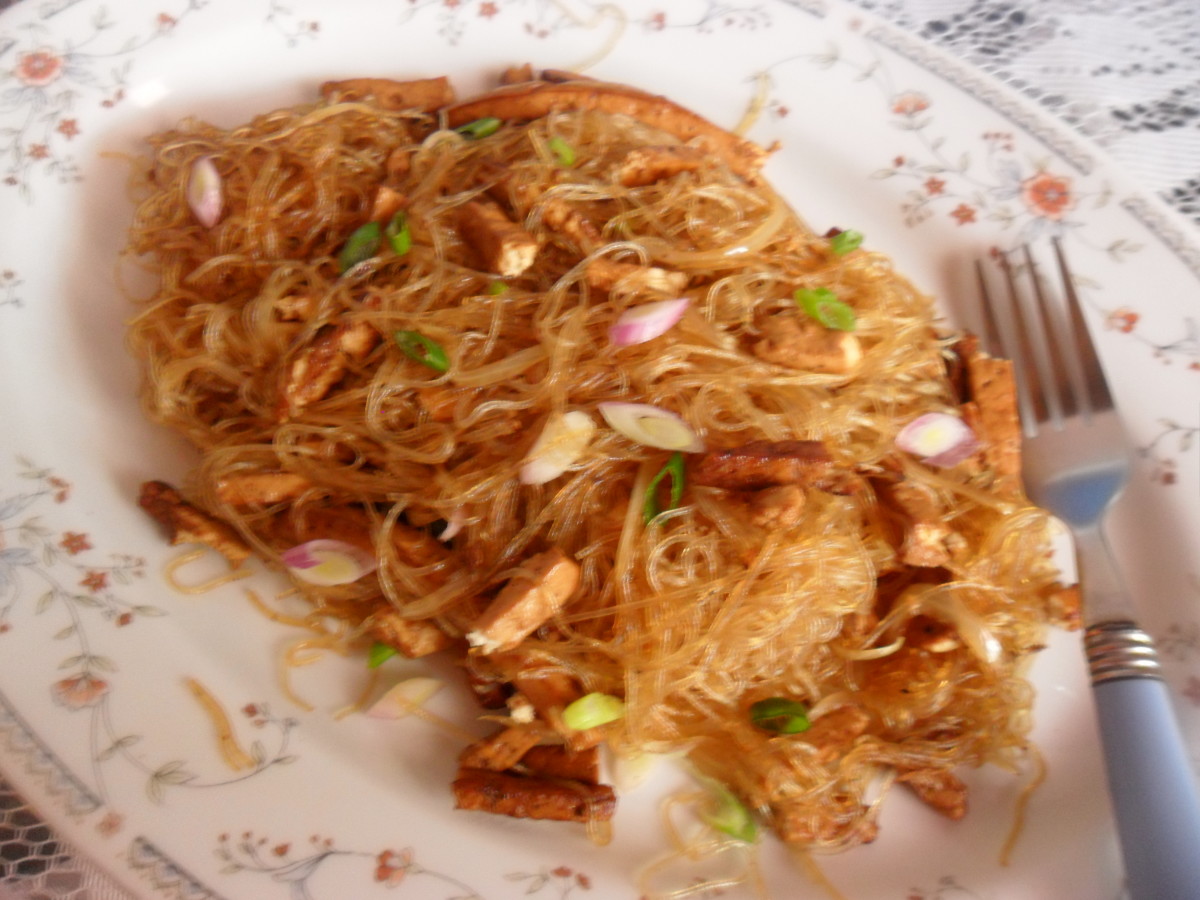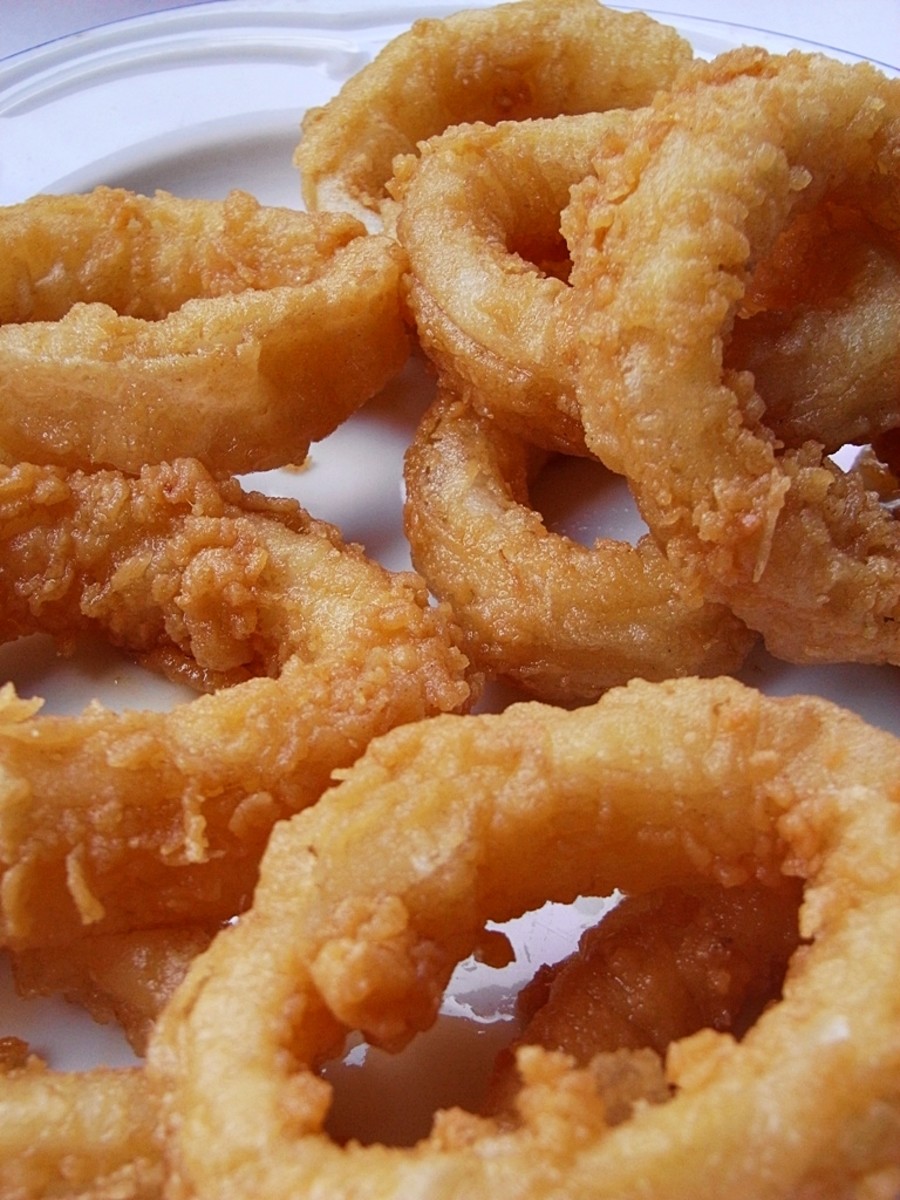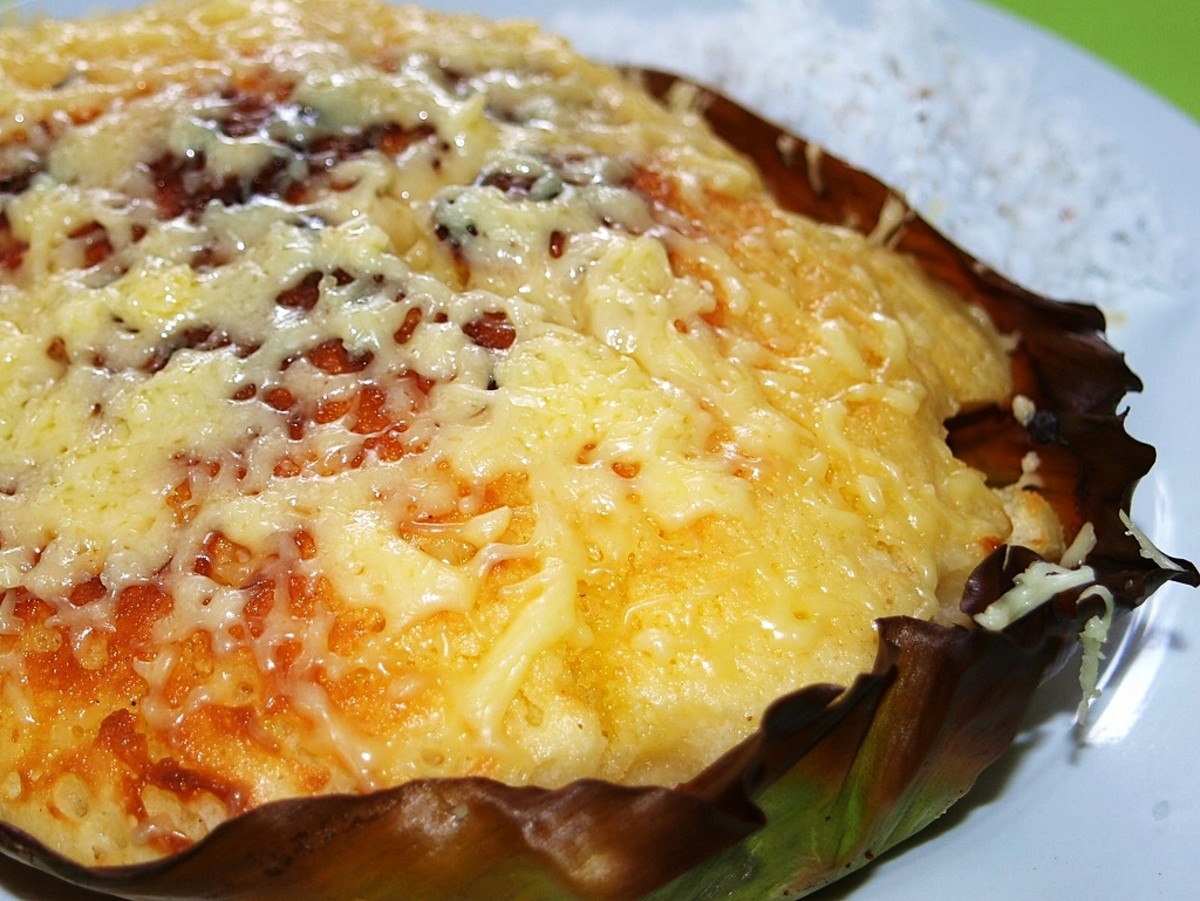- HubPages»
- Food and Cooking»
- World Cuisines»
- Southeast Asian Cuisine
Thai One On: Recipes for a Thai-Inspired Dinner Party
Are you looking for a culinary adventure for your next dinner party? Take your guests on a trip to Thailand with the elegant and exotic flavors of this Southeast Asian cuisine.
Don't be intimidated by strange ingredients and complicated preparations. This Iowa girl brought a love of Thai food home with me and made it accessible to my friends and family. The recipes I've adapted for our "Thai Fests" are simple enough for the average cook to master and use ingredients that can be found on the shelves of most grocery stores, yet are not lacking in the flavors you would expect to find in your favorite Thai restaurant. With these recipes and my suggestions for planning your own Thai Fest menu, it will be easy for you and your dinner guests to Thai one on.
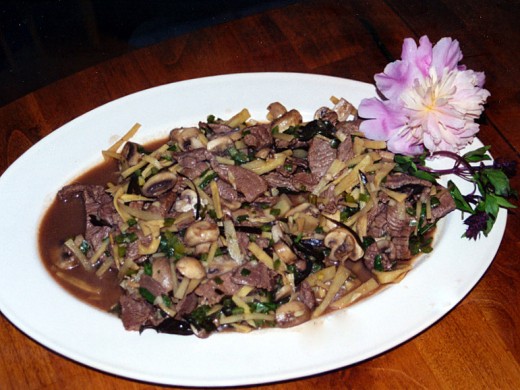
For the Love of Thai Food
Growing up in Iowa, an ethnic culinary experience tended to be nothing more adventurous than Americanized Chinese from a can, served over bland instant rice, and topped with those crunchy little noodles. Who knew chop suey wasn’t even from China? My post-graduation move to Chicago, with its multitude of diverse neighborhoods, brought opportunities for gastronomic exploration I never imagined possible during my meat and potatoes-filled youth. Authentic Chinese, Indian, and even Ethiopian meals were available just a short walk or cab ride away. But there was none I loved more than Thai food.
I had my first taste of Thai cuisine at the Thai Star Café in Chicago, a homey little restaurant with Formica tabletops and rickety chairs sporting torn vinyl cushions. Despite surroundings more reminiscent of my grandmother’s kitchen than Bangkok, I was swept away to another world. In this new world, food was elevated to an art form, with harmonious combinations of flavors, textures, and fresh ingredients. It was the most wonderful food I had ever tasted.
Thai food quickly became a mainstay of my diet. During many late nights at my large Chicago law firm, my co-workers and I would order in from our favorite Thai restaurant and eat together in a conference room. The long work hours became somewhat tolerable when accompanied by fresh spring rolls, curry, tom yum soup, green papaya salad, beef with basil leaves, and the other delicious food we shared.
I also enjoyed sharing the Thai experience with guests from out of town. When a group of my Iowa friends came to visit one weekend, I took them to dinner at one of Chicago’s finest Thai restaurants. Although they initially were skeptical of the unfamiliar food, it didn't take long before they were passing their plates around the table to get a taste of everything.
When I returned to Iowa in 1994, the thing I missed most about Chicago was the ready availability of Thai food. Instead of having at least six Thai restaurants within a two block radius of my apartment, there were none within an easy drive. While that has changed over time and there are now several options nearby, I learned to cook Thai food by necessity.
My first attempt at Thai cuisine was tom yum soup with prawns. One Saturday morning I made my first trip of many to the small Asian market in Cedar Rapids, which was then the only game in town. I was delighted to find a large walk-in cooler full of fresh Thai ingredients, including lemongrass and kaffir lime leaves, everything I needed for tom yum soup. I whipped up a huge pot of extra spicy soup in the tiny kitchen of my apartment, loaded it into the car, and headed over to my sister’s house where I fed it to my brother-in-law. I'll never forget his reaction. Sweating from the spicy heat of the soup, he didn't stop eating until every drop was gone. I had my first Thai convert.
It wasn't too long after that first attempt at Thai cooking that I instituted the tradition of Thai Fest among my friends and family. Everyone brought a Thai-inspired dish or two to share, and the meals stretched over hours. Now, countless Thai Fests later, we are accomplished Thai cooks. Our refrigerators and pantries are kept stocked with everyday Thai ingredients such as fish sauce and chili garlic sauce. We no longer save our recipes for Thai Fest; dishes such as Pad Thai have made it into the everyday dinner rotation.
Throwing your own Thai Fest
First, gather as big a group of culinary adventurers as you can manage. One of the best things about Thai food, whether you are ordering it in a restaurant or cooking it at home, is that an everyday meal so easily becomes a festive group event. Thai dishes are meant to be shared. The more diners there are, the greater variety of dishes you can order or prepare.
When planning the menu for your Thai Fest, remember that Thai meals do not feature one main dish. Rather, an array of dishes are presented at the same time. The ideal meal is a harmonious blend of spicy and cool, of sweet and sour, of crunchy and tender. All the senses should be engaged.
Pair a steaming, spicy curry with a cool, crisp salad. Add a soup, a noodle dish, and a side of rice. Have plenty of condiments and sauces on hand (peanut sauce is always a favorite) for additional seasoning to each diner's individual taste. Serve fresh tropical fruit for dessert.
Don't forget the cocktails. Fruity tropical drinks like the Mai Tai pair well with spicy food (and, while not Thai in origin, the name fits). Or serve a Thai beer like Singha or Chang.
The possibilities are endless. The recipes below will get you started. Gin kow!
Glossary of Thai Ingredients
Basil, Thai: Also known as holy basil. Believed to be sacred by the Hindus, this variety of basil has purplish stems and serrated-edged leaves with a slightly hot, anise flavor. It is commonly used in stir-fried meat dishes. Regular sweet basil may be substituted.
Bean sprouts: The tender sprouts of green mung beans. Store in the refrigerator for up to 3 days and remove the roots and green hulls before using.
Bean threads: Also known as cellophane noodles, these are thin translucent dried noodles made from the starch of mung beans. Thin rice vermicelli noodles or angel hair pasta may be substituted.
Chili garlic sauce: Also known as chili paste. A fiery hot condiment made from ground red chili peppers and garlic. Use in small quantities to add heat to soups and sauces, or use as a table condiment.
Chilies, Thai: Also known as bird peppers. These 1- to 2-inch green and red peppers are among the hottest varieties in the world. They are sliced thin or pounded and used to spice up soups, salads, curries, and sauces.
Cilantro: Also known as Chinese parsley or coriander leaves. The leaves, stems, roots, and seeds of this member of the carrot family are all used in Thai cooking. The leaves are often used for flavoring and garnishing sauces, soups, and salads. There is no substitute for the distinctive flavor of cilantro, but parsley may be substituted as a garnish.
Ginger: This rhizome of the ginger plant resembles a gnarled, tan root. Remove the skin to reach the peppery and sweet flavored flesh.
Fish sauce: Also known as nam pla. This is a bottled brown liquid with made from salted fermented fish. It is widely used in Thai cooking and as a condiment to add a pungent aroma and flavor. Often used in place of salt.
Kaffir lime leaves: Used to add a delicate floral aroma and flavor to soups and curries. Typically are not eaten, unless sliced into a very fine sliver. Remove before serving, like bay leaves. Kaffir lime leaves are available at most Asian markets. If fresh leaves are not available, use dried or frozen leaves.
Lemongrass: A long grass-like herb with a distinctive lemony flavor and aroma. One of the most commonly used herbs in Thai cuisine. The inner core of a lemongrass stalk can be eaten when finely chopped; larger pieces are used to add flavor but are removed before serving. The zest of half a lemon may be substituted for one stalk of lemongrass.
Mint leaves: Used in salads, stir-fried dishes, and as a garnish. Do not substitute dry mint if fresh leaves are not available.
Rice papers: Round brittle translucent sheets made from rice flour, water, and salt. Rehydrate before using as wrappers for spring rolls or summer rolls.
Rice stick noodles: Flat noodles made from rice flour, water, and salt. Available in a variety of widths and sold in folded bundles.
Rice vermicelli noodles: Also known as thin rice noodles. Wiry white noodles made from rice flour. Similar in appearance to bean threads.
Rice vinegar: A clear vinegar made from rice.
Tofu: A spongy white block of pressed soybean curd. Bland in taste but absorbs the flavors of ingredients with which it is mixed. An excellent source of low-fat protein. Store in the refrigerator, covered with water, for up to 5 days.
Hot and Sour Soup (Tom Yum)
This is adapted from the first Thai recipe I ever made.
2 boneless, skinless chicken breast halves, thinly sliced
3 stalks fresh lemongrass
4 cups chicken stock
8 kaffir lime leaves
3 cilantro sprigs with roots, plus 12 leaves
1 thin slice fresh ginger
2 cloves garlic, peeled
1 tablespoon chili garlic sauce
salt to taste
2 tablespoons lime juice
8 fresh whole tiny red Thai chilies, with stems
Discard tops of lemon grass, leaving 6 inches of stalk. Cut away hard roots and dry outer leaves and discard. Cut diagonally into 1-1/2 inch lengths; flatten with heavy knife.
In a large saucepan, bring stock, two-thirds of lemongrass, 4 lime leaves, cilantro sprigs, ginger, and garlic to boil. Reduce heat and simmer 15 minutes. Strain and discard solids. Return soup to pan. Add remaining lemongrass and chili garlic sauce and simmer for five minutes. Season with salt if needed. Add chicken and simmer until cooked through, about 5 minutes. Stir in remaining lime leaves, chilies, and cilantro leaves and ladle soup into bowls.
Serves 4.
Thai Beef Cucumber Cups
This isn't a traditional Thai dish, but makes a great appetizer for a Thai-themed dinner party.
2 English hothouse cucumbers
3/4 pound sirloin steak
2 green onions, finely chopped
2 tablespoons fresh lemon juice
2 tablespoons fresh lime juice
1/4 cup fish sauce
2 small red Thai chilies, finely chopped
2 teaspoons sugar
salt to taste
cilantro leaves for garnish
Trim ends off cucumbers. Peel and cut into 1" slices. Using a melon baller, carefully core out centers, leaving bottoms intact.
Sear beef in a nonstick skillet over high heat until medium rare. Cool, then finely chop. In large bowl, combine beef with scallions, lemon and lime juice, fish sauce, chilies, sugar, and salt to taste.
Spoon beef salad into prepared cucumber cups. Garnish with cilantro leaves.
Makes 24 appetizers.
Variation: Instead of cucumber cups, serve beef salad in endive leaves.
Fresh Spring Rolls
Make a double batch of these popular Thai bundles because they will go quickly. See the sidebar below for tips on how to assemble.
1/2 pound boneless pork loin
2 ounces rice vermicelli noodles or bean threads
8 large cooked shrimp, shelled and cut in half lengthwise
1 large carrot, shredded
8 small lettuce leaves
1 cup bean sprouts
8 sprigs fresh mint
8 sprigs fresh cilantro
8 rice papers
Half-fill a small saucepan with water and bring to a boil. Add pork loin and simmer until tender, 15 to 20 minutes. Drain pork, rinse with cold water, and drain again thoroughly. When pork is cool enough to handle, cut horizontally in half and then cut across the grain into 1/8-inch slices.
Bring a large pan of water to a boil. Add the noodles and simmer until tender but still slightly chewy, 1 to 2 minutes for rice vermicelli noodles and 30 seconds for bean threads. Stir occasionally to prevent sticking. Drain, rinse with cold water, and drain again thoroughly. Cut into 2 to 3 inch lengths.
Arrange pork, noodles, and remaining filling ingredients on a large plate. Working with one sheet at a time, soak rice paper in bowl of hot water until pliable (a few seconds). Fill rice paper with each of the filling ingredients. Roll like an egg roll, drain for a second or two on a towel to remove excess water, and move to a serving platter. Serve with Chili Dipping Sauce.
Makes 8 spring rolls.
How to Assemble a Spring Roll
Pour about 1/2-inch of hot water into a shallow dish. Working with 1 sheet of rice paper at a time, dip rice paper into water to moisten and soften it, 20 to 25 seconds. Carefully remove it from the water and drain on a dry dish towel.
Place filling on a third of the rice paper. Roll up the paper, halfway, into a cylinder. Fold both sides of the rice paper over the enclosed filling. Continue rolling into a 5-inch long cylinder and press the end lightly to seal. If the rice paper seems dry as you are working with it, brush it lightly with a little more water. Place the roll, seal side down on serving tray and cover with a dampened dish towel to keep moist.
Chili Dipping Sauce
This is a great condiment to serve with fresh spring rolls or to spice up any dish. It's even good on plain white rice.
2 cloves garlic, finely chopped
1 small red Thai chili, seeded and finely chopped
2 tablespoons sugar
1/4 cup rice vinegar
1/4 cup fish sauce
1/4 cup water
2 tablespoons lime juice
Grated carrot
In a small bowl, combine garlic, chili pepper, sugar, rice vinegar, fish sauce, and water. Pour in lime juice and stir until thoroughly mixed. Garnish with grated carrot.
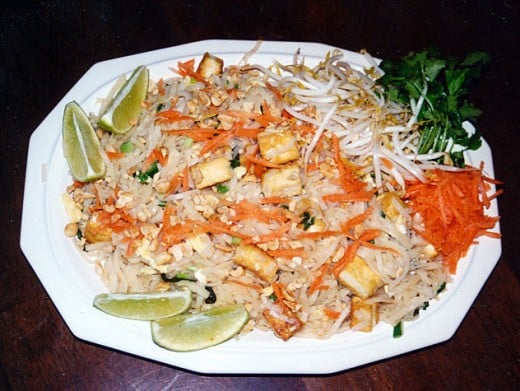
Pad Thai
This is my own adaptation of a traditional Thai dish. This recipe is easy enough to make for a quick week-night dinner.
More resources for Thai recipes:
8 ounces thick rice stick noodles
5 tablespoons vegetable oil
4 ounces firm tofu, cut into 1" cubes
2 cloves garlic, minced
1/3 cup fresh lemon juice
1/4 cup fish sauce
1/3 cup brown sugar
2 eggs, beaten
1/4 cup sliced green onions
2-3 green Thai chilies, thinly sliced
1/4 cup chopped fresh cilantro
1/4 cup chopped fresh Thai basil
1 carrot, grated
1 cup bean sprouts
1/2 cup chopped peanuts
1 lime, cut into 4 wedges
Cook noodles as directed on package. Drain thoroughly and set aside.
Heat oil in wok over medium-high heat. Add tofu and cook, stirring constantly, until golden, 1 to 2 minutes. Drain on paper towels. Drain all but 2 tablespoons oil from pan and return to medium-high heat. Add garlic and cook, stirring constantly, for 30 seconds. Add lemon juice, fish sauce, and sugar, stirring until sugar is dissolved. Mix in noodles.
Push noodle mixture to one side of wok. Add eggs and cook, without stirring, until partially set, then stir gently until scrambled. Stir egg through noodle mixture. Add tofu, green onions, chilies, cilantro, and basil. Cook until heated through, about 1 minute.
To serve, divide among plates and garnish with grated carrot, bean sprouts, and chopped peanuts. Accompany with lime wedges.
Serves 4.



